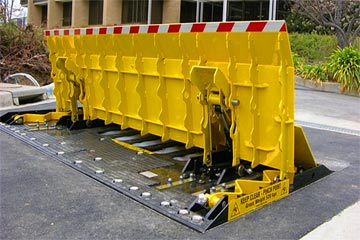The Wedge Barriers Ideas
Wiki Article
The Basic Principles Of Wedge Barriers

Wedge Barriers - The Facts
The remaining pressure applied to the cam webcam deploy release wedge plate 16 may be provided offered an electromechanical actuator 84 or other various other. The springtime setting up 54 and the actuator 84(e. Wedge Barriers. g., electromechanical actuator)might operate with each other to translate the web cam and lift the wedge plate 16.
As mentioned over, the springtime assembly 54 exerts a constant pressure on the cam, while the electromechanical actuator might be managed to exert a variable pressure on the camera, consequently enabling the training and lowering( i. e., releasing and pulling back )of the wedge plate 16. In certain embodiments, the consistent force used by the spring setting up 54 may be flexible. g., electromechanical actuator) is impaired. As will be valued, the springtime assembly 54 might be covered and protected from debris or various other aspects by a cover plate(e. g., cover plate 68 received FIG. 4) that may be considerably flush with the elevated surface 38 of the structure 14. As pointed out above, in the deployed setting, the wedge plate 16 offers to obstruct accessibility or traveling beyond the barrier 10. For example, the barrier 10(e. g., the wedge plate 16 )may block pedestrians or automobiles from accessing a residential or commercial property or path. As talked about above, the obstacle 10 is attached to the anchor 30 safeguarded within the foundation 14,

front brackets 71. As an outcome, the linkage settings up 72 may pivot and turn to allow the collapse and extension of the affiliation settings up 72 during retraction and deployment of the bather 10. The linkage settings up 72 cause motion of the wedge plate 16 to be limited. For instance, if a lorry is taking a trip in the direction of the his explanation deployed wedge plate 16(e. For instance, in one scenario, the safety legs 86 might be extended throughoutupkeep of the barrier 10. When the safety and security legs 86 are released, the security legs 86 support the weight of the wedge plate 16 against the surface area 12. As an why not check here outcome, the lifting mechanism 50 may be shut down, serviced, gotten rid of, replaced, and so forth. FIG. 5 is partial viewpoint sight of a personification of the surface-mounted wedge-style obstacle 10, showing the web cam 80 and the web cam surface areas 82 of the training system 50. Especially, 2 cam surface areas 82, which are described as lower webcam surfaces 83, are placed below the camera 80. The reduced web cam surface areas 83 might be fixed to the surface 12 (e. For instance, the reduced webcam surfaces 83 and the mounting plate 85 may form a solitary piece that is secured to the anchor 30 by bolts or various other mechanical bolts. In addition, two cam surfaces 82, which are referred to as top cam surfaces 87, are positioned over the camera 80 and coupled to (e. In other embodiments, stepping in layers or plates may be positioned in between the surface 12 redirected here and the reduced webcam surfaces 83 and/or the wedge plate 16 and the top web cam surface areas 87 As stated above, the cam 80 translates along the cam surfaces 82 when the wedge plate 16 is raised from the withdrawed setting to the released setting. In addition, as pointed out above, the spring setting up 54 (see FIG. 3 )may supply a force acting upon the web cam 80 in the direction 102 by means of springtime pole 58, which might minimize the pressure the electromechanical actuator 84 is required to apply to the camera 80 in order to activate and raise the wedge plate 16. 1 )to the released setting(see FIG. 4). As revealed, the web cam 80 includes track wheels 104(e. g., rollers), which call and convert along the cam surface areas 82 throughout operation.
Report this wiki page